|
|
|
Sort Order |
|
|
|
Items / Page
|
|
|
|
|
|
|
| Srl | Item |
| 1 |
ID:
162448
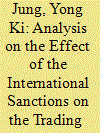

|
|
|
|
|
| Summary/Abstract |
Since the two North–South Korean Summits on April 27 and September 18, 2018,
the relationship between the two countries is thawing at a neck-breaking pace. And
the media is busy churning out optimistic forecasts about the reunification of the
two Koreas. However, as the governments of South Korea and the United States
have officially stated, the lifting of sanctions on North Korea can be considered only
after an agreement between the related countries on denuclearization is reached.
Also, considering the fact that denuclearization itself is a lengthy, stepwise process
that takes years, it is likely that the lifting of sanctions would happen in line with
progress on denuclearization
|
|
|
|
|
|
|
|
|
|
|
|
|
|
|
|
| 2 |
ID:
162446


|
|
|
|
|
| Summary/Abstract |
The foreign policy behavior of North Korea remains puzzling to many observers
to date. This article aims to explain Pyongyang’s foreign behavior between 1995
and 2011 with a concept called the balance of dependence. Although it stood on
the brink of collapse in the 1990s, the North Korean regime defied the odds and
survived with the help of neighboring countries, namely South Korea, Japan, China,
Russia, and the United States. This article intends to explain Pyongyang’s foreign
policy under Kim Jong Il by focusing on how it deliberately built a portfolio of
dependence on its neighbors. I argue that North Korea’s foreign behavior had been
attuned to the rise and fall of assistance from other nations. It sought to disperse its
dependence among a host of potential sponsors in order not to be exclusively reliant
on a single donor state, fearing restrictions on its political autonomy. As long as its
neighbors are willing to help out, Pyongyang will continue to play one sponsor off
the others while making progress with its nuclear and missile programs.
|
|
|
|
|
|
|
|
|
|
|
|
|
|
|
|
| 3 |
ID:
162451
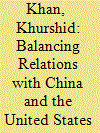

|
|
|
|
|
| Summary/Abstract |
It is always a risky affair, especially for a weak state to strike the right balance while
dealing with two great powers having serious conflicting interests in a particular
region. For a country like Pakistan which remains dependent on foreign aid, running
an independent foreign policy seems quite difficult. While Pakistan’s relations with
China continued to remain smooth throughout history, its relations with the United
States has been more of a roller coaster than a smooth ride but still both could never
be too apart from each other because of various compelling reasons. Currently,
China and Pakistan are extensively engaged in promoting their mutual economic
and strategic interests that go against the U.S. interests. Therefore, in the case of a
possible conflict between United States and China, Pakistan might be trapped in
a catch-22 because it cannot afford to infuriate the United States beyond certain
limits. In such a trap, staying neutral might be even riskier. Slow and steady change
in the status of Gilgit–Baltistan beyond a certain level for promotion of the China–
Pakistan Economic Corridor (CPEC) would also be a serious trap. Pakistan could
afford to lose economic benefits of the CPEC but it cannot afford to give up its
claim over Kashmir which remains the “lifeline” for its survival. Pakistani Generals
fighting on exterior fronts must therefore, make smart moves to ensure that at no
stage should Islamabad be compelled to put all its eggs in one basket.
|
|
|
|
|
|
|
|
|
|
|
|
|
|
|
|
| 4 |
ID:
162450
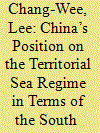

|
|
|
|
|
| Summary/Abstract |
China has a long coastline of approximately 18,000 kilometers and hence an
extensive continental shelf as well as an EEZ. Its coastline is said to be the tenth
longest coastline in the world. The total sea area in the China Seas is about 4.7
million square kilometers. Despite these advantageous circumstances in geography,
China failed to become a maritime power like Spain, Portugal, the Netherlands and
the UK. So it remained a land power for a long time except when Zheng He, the
great seafarer in Chinese history, led the greatest ocean-going fleets of the world of
that time, sailing to the Pacific and Indian Oceans during the years of 1405–1433.
As a result, China suffered foreign invasions several times from the sea, being
defeated in the Opium War as well as at the Sino–Japanese War in the nineteenth
century
|
|
|
|
|
|
|
|
|
|
|
|
|
|
|
|
| 5 |
ID:
162449
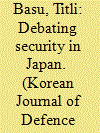

|
|
|
|
|
| Summary/Abstract |
Since the post–war era, understanding Japan’s security rhetoric and actions
presented certain incongruities. While the constructivist arguments underscore that
the influence of post–war antimilitarist norm shaped Japan’s security behavior, it
contradicts the realist underpinnings influencing Japan’s choices. To understand
Japanese post–war security orientation and comprehend the rapidly unfolding policy
shift, this paper explores three sets of questions: firstly, what are the competing
schools of thought in the Japanese security debate? What are their core arguments
on key issues including Article 9 of the Constitution, potency of the Self–Defense
Forces (SDFs), nature of the U.S.–Japan alliance and historical narratives of Japan’s
past? What are the inter-school and intra-school fault lines? Secondly, what are the
drivers that propelled the dominance of each school at different time frames? How
does the factional power struggle in the domestic political landscape enable each
school to maximize their space and influence in the current security discourse?
More specifically, why did mercantilists remained the dominant political force
throughout the Cold War? In contrast, what led to normalists gaining momentum
and substituting mercantilism as a potent force in the post–Cold War period?
Thirdly, how have political elites pursued their competing agendas and critically
analyze the case of Shinzo Abe? What are the influences that shaped his values?
What are the methods he employed to pursue his ambitions of making Japan a
“normal” nation? And how did he consolidate his political strength and manage to
realize concrete policy objectives?
|
|
|
|
|
|
|
|
|
|
|
|
|
|
|
|
| 6 |
ID:
162445
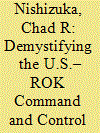

|
|
|
|
|
| Summary/Abstract |
The “transfer of wartime OPCON” from the United States to the Republic of
Korea, in conjunction with the termination of the obsolete Armistice Agreement,
may provide a unique opportunity for the Alliance to simplify and streamline
its command and control (C2) processes. The C2 structure in South Korea is
complicated by the coexistence of four distinct theater-level commands, the ROK
Joint Chiefs of Staff (JCS), United States Forces Korea (USFK), the Combined
Forces Command (CFC), and the United Nations Command (UNC), all of which
have a unique command structure and set of objectives. As the ROK continues
to grow stronger, both economically and politically, the four commands are
experiencing increasing difficulties synchronizing competing government policies.
The U.S. and ROK governments’ aptitude to address policy differences have a
direct impact on the ability of the four commands to achieve their end-states,
both individually and as a cohesive unit. This paper demonstrates that through the
reorganization of the Combined Forces Command and the elimination of conflicting
responsibilities emanating from the United Nations Command, the U.S.–ROK
Alliance could become more formidable by increasing simplicity, the unity of
command, and the span of control of the current C2 structure.
|
|
|
|
|
|
|
|
|
|
|
|
|
|
|
|
| 7 |
ID:
162447


|
|
|
|
|
| Summary/Abstract |
With the PyeongChang Winter Olympics and Paralympics as an impetus, the two
Koreas and the United States have cast diplomatic maneuvers incessantly to devise
a peaceful solution to the North Korean nuclear issue and the Korean Peninsula
issue overall. Recently, the inter–Korean Summit and DPRK–U.S. summit resulted in
the signing of the Panmunjeom Declaration and the Joint Statement in Singapore after
talks for North Korea’s complete denuclearization and the peace regime on the Korean
Peninsula. In addition, Pyongyang declared that the byungjin line was successfully
carried out and announced that the state will focus on “economic construction.”
Nevertheless, the Kim Jong Un regime’s credibility and resolve for denuclearization are
the preconditions for peace and prosperity of the Korean Peninsula.
In this sense, this article commences with two research questions: Why has the Kim
Jong Un regime changed its economic development strategy, departing from the
previous byungjin line?; and How can we understand North Korea’s changes in a
national policy? Most of all, this paper will analyze the influence of North Korea’s
transition to an “economy-first” strategy this year on the politics of the Korean
Peninsula and discuss the South Korean government’s strategy regarding North
Korea for peace on the Korean Peninsula in the future.
|
|
|
|
|
|
|
|
|
|
|
|
|
|
|
|
| 8 |
ID:
162452
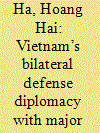

|
|
|
|
|
| Summary/Abstract |
The paper explores the development of Vietnam’s bilateral defense diplomacy with
world and regional powers including the United States, India, and Japan, with a
particular focus on the period from 2009 to 2018. The paper finds that Vietnam’s
multidirectional defense diplomacy is fundamentally shaped by its historical
experience, the contemporary shift in the balance of power and the strategic
challenges caused by China’s emerging power. By pursuing a multi–polar balance
among major partners, Vietnam avoids being pulled into their rivalry, and keeps its
non-alignment as well as strategic autonomy. The international defense cooperation
has become further deepened and more substantive to satisfy Vietnam’s strategic
interests including national security, territorial integrity, economic development
and regime legitimacy. However, domestic and geo–strategic constraints, and
asymmetrical economic interdependence with China lead this paper to suppose
further challenges in the future of Vietnam’s defense diplomacy.
|
|
|
|
|
|
|
|
|
|
|
|
|
|
|
|
|
|
|
|
|